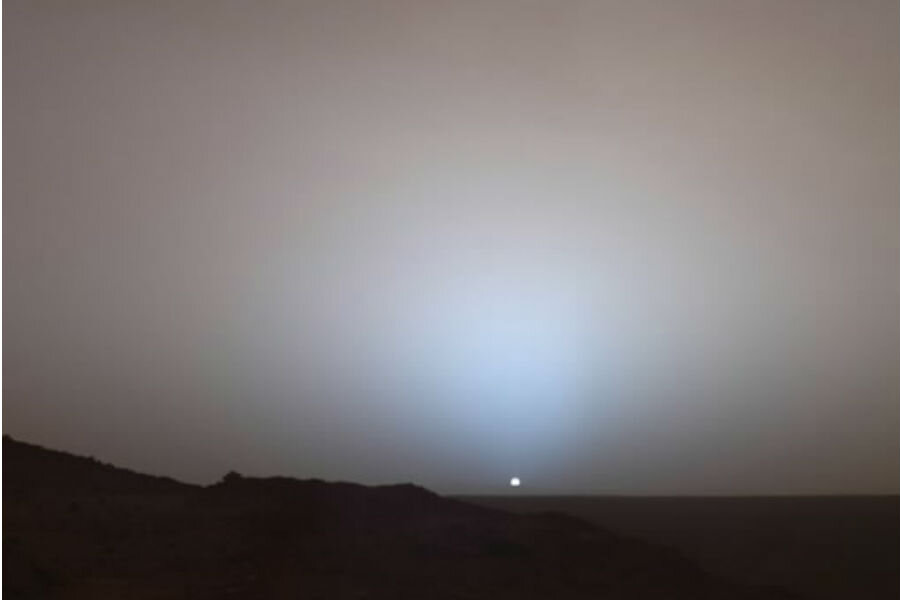Did an asteroid trigger ancient tsunamis on Mars?
A team of scientists believes that an asteroid impact at the site of Mars' Lomonosov crater may have been responsible for the massive tsunamis thought to have swept the region three billion years ago.
Scientists have hypothesized before that asteroid impacts could have created tsunamis during Mars' watery past. But this is the first time a specific crater has been tied to a specific tsunami on the Red Planet.
While many scientists say that the Martian surface was covered with water, the extent of that coverage is still widely debated. During the course of the study, the researchers noticed that certain lobate deposits, frequently associated with water movement on ancient Mars, seemed to have flowed into the southern region of the planet from where a northern ocean would have been located.
"We found typical tsunami deposits along the dichotomy between the northern hemisphere and southern hemisphere of Mars," François Costard, lead author of a study on the event, told the BBC. "It supports [the idea] that there was, at that time, a northern ocean."
The giveaway was a set of geological formations that look like the ridges in a human fingerprint – but on a much larger scale.
"There's...[a] set of landforms that we see along the coastline called thumbprint terrain," Stephen Clifford, study co-author, told the BBC. "The reflection of the tsunami waves from the coast and their interaction with a second set of tsunami waves, predicted by the numerical modeling, would have resulted in sediment deposition that's very similar to what we actually observe on Mars."
According to the study, published in the Journal of Geophysical Research—Planets, the source of these tsunami features was one of a few possible asteroid impacts that could have hit the northern ocean at the time. But the most likely culprit was the explosive impact that created the 75-mile-wide Lomonosov crater.
"It was a really large-scale, high speed tsunami," said Dr. Costard. "At the very beginning, a crater of 70 kilometers [43.5 miles] in diameter was created by the impact. This expelled a huge volume of water, with wave propagation at 60 meters per second [134 miles per hour]. The initial wave was about 300 meters [984 feet] in height. After just a few hours, that tsunami wave reached the paleo-shoreline located at a few hundred kilometers from the impact crater."
The impact would have created two separate waves, leaving deposits as far away as 95 miles inland with wave heights of about 330 feet.
But despite the researcher's explanation for the geological features, studies like this have been doubted before. Previously, the deposits the team used to deduce the tsunami event had been blamed on other phenomena, such as mud flows or glacier movements, and Mars' current inhospitable dryness makes it difficult to know exactly what the surface was like three billion years ago. As The Christian Science Monitor reported last year:
Astronomers know that there was liquid water on ancient Mars based on the planet's barren and dry landscape today, which appears to have been shaped by flowing water. There is also water frozen at the planet's polar ice caps. But how much water was on Mars, for how long, and whether in the form of an ocean, rivers, or streams are questions that scientists haven't settled. The history of water on Mars is a significant factor to nail down, since it is inextricably tied to the question of potential life on the planet.
NASA scientists last year reported on their analysis of water vapor in the Martian atmosphere. Their findings also suggested that there was an ocean in the planet's northern plains, where the landscape is more depressed, like on Earth's ocean floor, than on other parts of the planet. The body of water was vast enough 4.5 billion years ago to cover a fifth of Mars, these scientists reported.
As Mars lost its atmosphere over billions of years, it lost the pressure and heat needed to keep water liquid, so the water receded. Whatever water was leftover, suggested the team led by NASA's Geronimo Villanueva, condensed and froze at the polar ice caps.
"It's very hard to conceive of any other process other than a tsunami that could have emplaced these lobate deposits along the dichotomy boundary," Dr. Clifford told the BBC. "There is ambiguity in all the various lines of evidence that have been cited regarding whether Mars is water-rich or water-poor. But the morphologic evidence that's been presented here is a very persuasive case for a water-rich planet."
And if Mars was once able to support oceans of water, as this study would indicate, it is possible that the Red Planet might have been able to support life as well.
"If we do have this evidence of a tsunami having occurred back three billion years ago, there must have been an ocean present in the northern plains," said Clifford. "That's the key point here, it indicates that there was a substantial amount of water in residence on the Martian surface at this time and that has likely implications for the total inventory of water on Mars."






